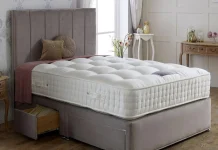Perfect design and wall painting seem to be impossible. However, we don’t share such opinions! The best decoration of the room is possible, and if you stick to our expert advice, then you could make your dwelling look even more attractive. We suggest you look at a few of them to understand what the choice of painting depends on.
Table of Contents
1. Think about Personal Taste
There are so many styles, propaganda of what is fashionable and what is not on Instagram photos, and patterns of what piece of art should be chosen … And you need to pick up a single design from all of this variety. Just how to do it? Which style is better: Scandinavian, minimalist, Provence? The solution is really simple and it is up to you – listen to yourself. Firstly, it is important to remember that the house is where you feel comfortable, protected, and free. And so choose the style of art based on your own associations and feelings, rather than the ideal fashion pictures that are popular in social networks. Secondly, you should take into account the fact that you choose the design, style, and art for yourself and not for others. This is your space. Let it show your guests who you really are.seascape oil paintings by Richard Stanley
2. Work with the Existing or Potential Style of the Room
Before you make a design in the room, you must first understand the category of the building. Today, the house is represented by different types: lofts, cottages, rooms. Each type of premises has its own characteristics in terms of area, planning and operation. The design of the room will depend on how big or small it is. For example, the design of small rooms is usually limited in materials, textures and shades. Otherwise, there is a risk of making the room uncomfortable and cramped. It can be a room for rest and sleep, reception, work or study, cooking, hygiene procedures and more. Some apartments can combine several rooms. For example, a studio usually does not have a wall between the living room and the kitchen. Consider all the details that may in one way or another affect the current or potential style of the rooms.
3. Take Walls and Furniture into Account
Do not forget about the surrounding of wall art! Furniture, types of walls… they can be fatal when choosing art. If the wall on which you are going to hang a picture has too expressive surface texture or bright paint, then place the canvas in a wide mat. Its wide margins will play a good “protective” role here: the subtle details of the work of art, its soft color transitions will not be lost against the background of an actively textured wall. Square, round, oval or rectangular frames create a special geometry that either emphasizes the smoothness of the lines in the environment or smooths out complex configurations and the overall awkwardness of the room. The choice of painting also depends on the color and texture of the furniture. They should blend harmoniously, match approximately the same color scheme and not seem contrasting.
4. Enhance or Rearrange Existing Artwork
A great opportunity to show your talent, creativity and art. Do you have an old wall map? Did you want to throw it away? No way! Currently, world map wall decor is one of the most popular and widespread types of art in the design universe. So, try to make beautiful wall art from it. Use the technique of Kunsaiga, a Japanese technique that arose out of a desire to remake an old kimono, or rather to use expensive silk again. In Japan, a board was used as a basis and sketches were made on it. By inserting pieces of kimono into the holes, they created real masterpieces of art. Now this exciting activity is spread all over the world. Kinusaiga is a patchwork technique where you don’t need a thread or a needle. Connoisseurs of patchwork paintings will love this technique. Its big plus is that you can create pictures with your child as well. To start with, I advise you to choose easier drawings with large elements.
5. Be Aware of the Size of Your Space
It is necessary to refrain from a set of furniture items and to leave the most required ones, according to the purpose of the room. A bed, a small wardrobe – perhaps this will be the decoration of a small room. Otherwise, the bedroom will turn into a “Chinese box” filled with the things of its owner. Guided by the principle of minimalism in the design of a room, remember that one large (but shallow) cabinet is better than individual shelves and so on. Also note the color choices: it is better to make small rooms light and choose light shades, as light color makes the room visually larger, and dark colors work in reverse.
6. Themes Can Highlight a Mood or Create a Vibe
In many ways, the mood in which a person is inside the room creates existing works of art there. Looking at the pictures you choose, other people will involuntarily draw certain conclusions about you. This is especially important when it comes to the workplace where you interact with your customers. Paintings are perceived by them as a “business card” that carries information about your image and business concept. Therefore, care should be taken to ensure that this information reflects the truth and creates a good impression. When choosing a painting, try to assess what feelings and thoughts you have when considering a work of art. Note that your perception is influenced not only by the plot, but also the manner of writing, the color palette of the picture. And although there are certain criteria by which to assess the artistic value of the canvas, you do not have to be a fine connoisseur of art. All you have to do is listen to yourself, your heart, and your intuition. Be sure to consider the functional features of the room. Lyrical, soothing images, made, for example, in the pastel technique, are more suitable for the bedroom. The plot, which, for example, you can choose is the type of the calm sea surface. Decorate your child’s room with bright, fun, maybe even silly sketches. In the living room, you can buy landscape genre or architectural paintings, portraits, paintings of animals. In the office, as a rule, there should be more severe images.








